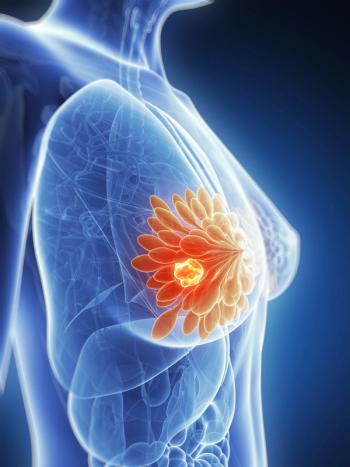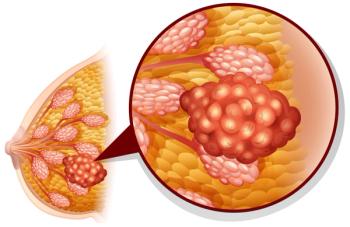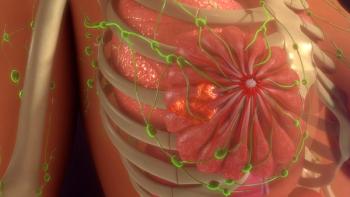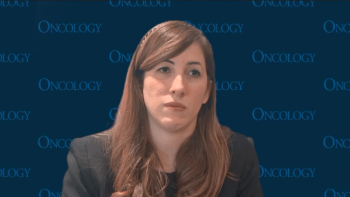
- ONCOLOGY Vol 12 No 1
- Volume 12
- Issue 1
Taxanes in Adjuvant and Neoadjuvant Therapies for Breast Cancer
Paclitaxel (Taxol) is a diterpene originally obtained from the bark of the Pacific Yew Tree, Taxus Brevifolia. Its mechanism of action is unique. it stabilizes microtubule polymerization, thus blocking cells in the G2/M phase of
ABSTRACT: Paclitaxel (Taxol) is a diterpene originally obtained from the bark of the Pacific Yew Tree, Taxus Brevifolia. Its mechanism of action is unique. it stabilizes microtubule polymerization, thus blocking cells in the G2/M phase of the cell cycle. In breast cancer, initial studies using paclitaxel demonstrated high activity. The first study was reported in 1991 by Holmes et al who gave paclitaxel as a 24-hour infusion at 250 mg/m² to 25 patients with metastatic breast cancer following only one prior chemotherapy regimenthey achieved a 56% response rate. Since then, numerous studies have confirmed the effectiveness of paclitaxel in patients with metastatic disease. a second taxane, docetaxel (Taxotere), has also demonstrated excellent activity. Clinical research is now focused on integrating the taxanes into combination drug regimens and into neoadjuvant and adjuvant schedules for patients with early stage breast cancer, as well as looking at the biologic determinants of response and resistance to taxanes. This article will review developments in the use of taxanes in the adjuvant and neoadjuvant settings and it will review the information on possible molecular markers that may be useful in predicting tumor responsiveness to taxanes.[ONCOLOGY 12(Suppl 1):23-27, 1998]
Two taxanes are currently available for the treatment of advanced breast cancerpaclitaxel (Taxol) and docetaxel (Taxotere). These agents have different and specific mechanisms of action, and this article will focus on the most extensively studied of them, paclitaxel. The observation that taxanes do not exhibit cross-resistance to doxorubicin (Adriamycin) underlies the international effort to bring them into the adjuvant and neoadjuvant setting. The role of taxanes, and specifically paclitaxel, in the adjuvant setting follows logically from their demonstrated activity against metastatic disease and from their lack of cross-resistance to doxorubicin. In the original series of 25 patients treated by Holmes et al, all but two had received prior doxorubicin and six were considered to be doxorubicin-resistant.[1] two partial responses were observed in the doxorubicin-resistant patients.
In a phase II trial of heavily pretreated patients (median number of prior chemotherapy regimens 3; range 2-6), investigators at Memorial Sloan-Kettering Cancer Center gave 51 patients paclitaxel 200 mg/m² by 24-hour infusion every three weeks and observed a response rate of 28%.[2] The same investigators subsequently studied patients who had received only one prior chemotherapy regimen for metastatic disease. After administering paclitaxel at 250 mg/m² to these patients, they observed a response rate of 48%.[2] In both of these studies, previous resistance to anthracycline did not predict resistance to paclitaxel. As expected, in patients with newly diagnosed metastatic disease, an even higher response rate of 62% was achieved and prior use of adjuvant anthracycline therapy did not decrease the likelihood of a response.[3]
Other studies limited to patients with anthracycline-resistant disease have confirmed the lack of cross-resistance between the two drugs. Wilson et al treated 36 metastatic breast cancer patients who had progressed after treatment with an anthracycline with paclitaxel given as a 96-hour infusion at 140 mg/m². They observed a response rate of 48%.[4] Response rates ranging from 29% to 46% have been achieved in trials of docetaxel in patients with anthracycline-resistant disease.[5-7]
Although adjuvant doxorubicin-based chemotherapy effectively cures approximately 20% to 35% of patients with micrometastases, most patients with micrometastatic disease after surgery eventually die of progressive breast cancer. The success of the current adjuvant regimens is thus tempered by the need for more effective regimens. This need, and the encouraging results observed in the setting of anthracycline-resistant metastatic disease, have resulted in high priority trials incorporating taxanes into adjuvant treatment regimens in North America and Europe.
One of the earliest trials to use paclitaxel in the adjuvant setting was conducted by Cancer and Leukemia Group B (CALGB). CALGB 9141 was designed as a pilot study to assess the feasibility of adding paclitaxel to dose- dense doxorubicin/cyclophosphamide (doxorubicin 75 mg/m², cyclophosphamide 2,000 mg/m², given every three weeks). One hundred and seventy two node-positive patients received five cycles of AC (doxorubicin and cyclophosphamide) followed by paclitaxel 175 mg/m² every three weeks, for four cycles. Preliminary follow-up at a median of 2.4 years showed a relapse-free survival of 87%; for patients with 10 or more positive nodes, relapse-free survival was 72%.[8]
Other studies still undergoing accrual or in follow-up are listed in Table 1. As evidenced by the wide variety of regimens in Table 1, there are many possible ways of incorporating taxanes into existing adjuvant schedules.
Taxanes may be given concurrently or sequentially with doxorubicin. In addition, paclitaxel itself may be given in a variety of doses and schedules, as shown in Table 2. Although the results of recent adjuvant trials will not be available for several years, most investigators believe they will confirm the importance of including a taxane. it may, however, be many years before the optimal regimen is defined. It is possible that the best approach will be to administer a taxane in the neoadjuvant setting followed by an anthracycline-based adjuvant regimen.
The administration of neoadjuvant chemotherapy to patients with breast cancer has been the standard of care for those with locally advanced disease (T3 or T4 tumors, or N2 or N3 nodes). At some institutions, additional chemotherapy is given following surgery. The advantages of neoadjuvant chemotherapy include the following:
1. Shrinking the tumor with chemotherapy before surgery may facilitate the removal of the tumor and permit breast-conserving surgery in patients with large tumors that would otherwise require mastectomy. The ability of neoadjuvant chemotherapy to permit breast conservation despite tumors initially too large has been well documented in clinical trials.[12]
2. Systemic chemotherapy is administered as soon as possible after diagnosis. This has a theoretical advantageIt may prevent the emergence of drug-resistant tumor clones.
There is evidence that some primary tumors elaborate substances that inhibit the vascularization and growth of micrometastases and that surgical removal of the tumor stimulates the growth of metastases.[13] Neoadjuvant therapy may treat micrometastases before removal of the primary tumor can stimulate their growth. Neoadjuvant therapy is given at a time when the tumors vascular bed is intact, allowing optimal drug delivery.
3. The response of the primary tumor to neoadjuvant chemotherapy can provide prognostic information. Studies have demonstrated that response to neoadjuvant chemotherapy predicts disease-free and overall survival.[14]
The results of NSABP Trial B18, comparing neoadjuvant AC (doxorubicin and cyclophosphamide times four cycles) to adjuvant AC, were reported at the 1997 meeting of the American Society of Clinical Oncology (ASCO). There was no difference in progression-free or overall survival between the two groups. In the neoadjuvant group, however, there was significant down-staging of tumors (a 37% increase in the incidence of pathologically negative nodes) and a substantially higher rate of breast conservation (67% vs 60% in the adjuvant group).[15]
The Buzdar Trial
Although most trials of paclitaxel in early stage breast cancer have incorporated it into postsurgical adjuvant regimens for patients at high risk of recurrence, several investigators have studied paclitaxel in the neoadjuvant setting. Buzdar et al recently reported the results of a randomized trial comparing paclitaxel alone to FAC (fluorouracil[5-FU], Adriamycin, and cyclophosphamide [Cytoxan]) given as induction therapy to patients with operable breast cancer.[16] Paclitaxel was administered as a 24-hour infusion every three weeks at a dose of 250 mg/m². As shown in Table 3, no difference between the groups was observed in the amount of residual disease present, either in the breast or in the axilla, at the time of surgery.
Patients on the paclitaxel arm experienced significantly more febrile neutropenia (7/37 patients for paclitaxel, compared to 2/41 patients for FAC). A substantially lower incidence of neutropenia was observed in a small pilot trial of neoadjuvant therapy using the same paclitaxel dose given over three hours (grade 3 neutropenia seen in 7% of patients), reflecting the schedule dependency of paclitaxel-induced neutropenia.[17]
The New York University Trial
At New York University, we began a trial of neoadjuvant paclitaxel for patients with palpable T2 or T3 tumors, followed by surgery, adjuvant AC (doxorubicin and cyclophosphamide) and in appropriate cases, radiation therapy. Paclitaxel is given at 200 mg/m² over three hours every two weeks. Seven patients have entered the trial. although it is too early to draw conclusions about the overall efficacy of this regimen, the neoadjuvant treatment appears to be well tolerated and all patients have demonstrated a clinical response to paclitaxel.
The Gianni Trial
Other investigators are studying paclitaxel in combination with doxorubicin in the neoadjuvant setting. Based on their experience with metastatic disease, Gianni et al conducted a pilot trial of neoadjuvant paclitaxel and doxorubicin in women with tumors greater than 3 cm or tumors otherwise locally advanced. They administered doxorubicin 60 mg/m² and paclitaxel 200 mg/m² over three hours every three weeks for four to six cycles before surgery. Their preliminary findings are summarized in Table 4.[18] They observed grade IV neutropenia in 69% of patients, but it was of short duration and clinically manageable.
The Anelli Trial
Anelli et al have also reported on the use of combined paclitaxel and doxorubicin given neoadjuvantly. They treated 20 patients with stage IIIB breast cancer. The first 10 patients received doxorubicin 60 mg/m² and paclitaxel 135 mg/m²; the second 10 received 175 mg/m² of paclitaxel. Three cycles of therapy were given before surgery. Eighty percent of patients responded clinically, and a complete histologic response was seen in 20% of patients.[19]
Neoadjuvant chemotherapy presents a unique opportunity to evaluate tumor specimens at time of diagnosis for characteristics that predict responsiveness to neoadjuvant chemotherapy. At the time of surgery, the effectiveness of chemotherapy can be objectively evaluated. as part of the study of neoadjuvant paclitaxel described above, we, at New York University Medical Center, are studying potential molecular markers of response to paclitaxel. The following molecular markers may reflect underlying biologic mechanisms that determine sensitivity or resistance to taxanes and are the subject of our investigation.
HER-2/neu is overexpressed in up to 25% of breast cancers.[20] Two studies have concluded that HER-2/neu overexpression predicts a lack of benefit from adjuvant CMF (cyclophosphamide, methotrexate, and 5-FU), whereas it correlated with a dose-response effect for doxorubicin.[21,22] Seidman et al reported a positive correlation between HER-2/neu positivity and response to paclitaxel in advanced breast cancer: 65.2% of patients with HER-2/neu positive tumors responded vs only 35.5% of patients with HER-2/neu negative tumors.[23] The mechanism underlying this apparent relationship is uncertain, but it may relate to paclitaxel interference with signal transduction pathways downstream from the EGF receptor-like protein encoded by HER-2/neu.[24]
p53 regulates the passage of cells through the cell cycle and is required for the induction of apoptosis in response to a variety of stimuli. Mutations that result in the loss of p53 function are associated with increased immunostaining. since mutant forms of p53 have a prolonged half-life, p53 immunostaining is positive in approximately 40% to 50% of breast cancers and is associated with shorter survival.[25] Drugs that produce DNA damage, such as doxorubicin and cisplatin, appear to use the p53-mediated pathway to apoptosis and loss of normal p53 function may impart resistance to these drugs. In contrast, there is evidence that loss of normal p53 function may increase sensitivity to paclitaxel because of increased G2/M arrest leading to p53 independent cell death.[26] Kandolier et al recently reported on 18 patients who received neoadjuvant paclitaxel for breast cancer and observed responses confined to patients with mutated p53.[27]
Multidrug resistanceClassic MDR-mediated resistance explains simultaneous tumor resistance to several structurally unrelated natural products. The MDR1 gene encodes for P-glycoprotein (P-gp), a membrane-bound protein that acts as an energy-dependent drug efflux pump.[28] In breast tumors that have not been exposed to chemotherapy, the range of P-gp positivity reported by various investigators has been wide, from 0% to 85% of specimens testeda discrepancy that relates to the varied methods of assaying for P-gp.[29] A significantly higher rate of P-gp positivity has been found in tumor samples from patients previously exposed to drugs, but again a wide range of positivity indicates different assaying methods and interpretation. Although these studies suggest that P-gp plays a role in the acquired drug resistance seen in breast cancer, it is still a matter of controversy. In vitro, both doxorubicin and paclitaxel appear to be P-gp substrates, an observation that calls into question the relevance of P-gp, because clinically, paclitaxel and doxorubicin do not exhibit cross-resistance.
In addition to the P-gp, a second drug efflux pump may be important in clinical drug resistance to taxanes: MRP, the multidrug resistance-associated protein. Although MRP, like P-gp, is a member of the ATP-binding cassette (ABC) family of transport proteins, the two proteins are structurally dissimilar, having only a 15% sequence homology.[30] MRP is able to transport a variety of hydrophobic anionic substrates including reduced glutathione. Both doxorubicin and paclitaxel appear to be MRP substrates. Although the role of MRP in clinical drug resistance in breast cancer has not been investigated as thoroughly as P-gp, preliminary evidence suggests that it may be important.[31]
The taxanes are a powerful class of drugs that represent a significant advance in the treatment of breast cancer. The full potential of taxanes has yet to be realized. In the adjuvant and neoadjuvant settings, in particular, it is anticipated that taxanes will have a role in decreasing breast cancer mortality. High response rates in previously untreated patients, the lack of clinical cross-resistance to anthracyclines, and patient tolerance are noteworthy features encouraging these strategies. Current research into the molecular mechanisms that underlie resistance to taxanes may lead to its early recognition and to methods that overcome the drug resistance, thus providing even more effective treatments in the future.
References:
1. Holmes F, Walters R, Theriault R, et al: Phase II trial of Taxol, an active drug in the treatment of metastatic breast cancer. J Natl Cancer Inst 83:1797-1805, 1991.
2. Seidman A, Reichman B, Crown J, et al: Phase II trial of paclitaxel by 3-hour infusion as salvage chemotherapy for metastatic breast cancer. J Clin Oncol 13:2575-2581, 1995.
3. Reichman B, Seidman A, Crown J, et al: Paclitaxel and recombinant human granulocyte colony stimulating factor as initial therapy for metastatic breast cancer. J Clin Oncol 11:1943-1951, 1993.
4. Wilson W, Berg S, Bryant G, et al: Paclitaxel in doxorubicin-refractory or mitoxantrone-refractory breast cancer. A phase I/II trial of 96-hour infusion. J Clin Oncol 12:1621-1629, 1994.
5. Valero V, Holmes F, Walters B, et al: Phase II trial of docetaxel: a new highly effective antineoplastic agent in the management of patients with anthracycline resistant metastatic breast cancer. J Clin Oncol 13:2886-2894, 1996.
6. Ravdin P, Burris H, Cook G: Phase II trial of docetaxel in advanced anthracycline-resistant or anthacenedione-resistant breast cancer. J Clin Oncol 13:2879-2885, 1995.
7. Guastalla J, Bonneterre J, Fumoleau P, et al: A phase II trial of docetaxel in patients with anthracyline resistant metastatic breast cancer. 8th European Conference on Clinical Oncology and Cancer Nursing, Paris, 1995.
8. Demetri G, Berry D, Norton L, et al: Clinical outcomes of node positive breast cancer patients treated with dose-intensified Adriamycin/cyclophosphamide followed by Taxol as adjuvant systemic chemotherapy in (CALGB9141). Proc Am Soc Clin Oncol 16:143a, 1997.
9. Upadhyaya G, Muggia F, Rogers M: Biweekly paclitaxel 3-hour infusion: tolerance without G-CSF in minimally pre-treated patients. Proc Am Soc Clin Oncol 14:470, 1995.
10. Fennelly D, Shapiro F, Aghajanian C: Dose-intensive paclitaxel delivery utilizing a weekly one-hour infusion schedule: efficacy and feasibility in patients with persistent ovarian cancer. Proc Am Soc Clin Oncol 15:286, 1996.
11. Sikov W, Akerly W, Cummings F, et al: High-dose weekly paclitaxel for locally advanced and metastatic breast cancer. Proc Am Soc Clin Oncol 16:191a, 1997.
12. Harris L, Swain S: The role of primary chemotherapy in early breast cancer. Semin Oncol 23:31-42, 1996.
13. Holmgren L, OReilly M, Folkman J: Dormancy of micrometastases: balanced proliferation and apoptosis in the presence of angiogenesis suppression. Nat Med 1:149-153, 1995.
14. Feldman L, Hortobagyi G, Buzdar A, et al: Pathological assessment of response to induction chemotherapy in breast cancer. Cancer Res 46:2578-2581, 1986.
15. Fisher B, Mamounas ABE, et al: Effect of preoperative chemotherapy on local-regional disease in women with operable breast cancer: findings from National Surgical Adjuvant Breast and Bowel Project B-18. J Clin Oncol 15:2483-2493, 1997.
16. Buzdar A, Morris A, Hortobagyi G, et al: Prospective randomized trial of Taxol alone vs an induction therapy in patients with operable cancer. Proc Am Soc Clin Oncol 16: 141a, 1997.
17. Lara F, Ramirez M, Guevara A, et al: Neoadjuvant Taxol in stage III breast cancer. Proc Am Soc Clin Oncol 16:179a, 1997.
18. Gianni L, Straneo M, Capri G, et al: Optimal dose and sequence finding study of paclitaxel by 3-hour infusion combined with bolus doxorubicin in untreated metastatic breast cancer. J Clin Oncol 13:73, 1994.
19. Anelli A, Albuquerque Ad, Tabacof J, et al: Paclitaxel and doxorubicin as neoadjuvant chemotherapy in locally advanced breast cancer - preliminary results. Proc Am Soc Clin Oncol 16:158a, 1997.
20. Berns E, Klijn J, Stavern IV, et al: Prevalence of amplification of the oncogenes c-myc, HER-2/neu and int-2 in one thousand human breast tumors: correlation with steroid receptors. Eur J Cancer 28:697-700, 1992.
21. Gusterson B, Gelber R, Goldhirsch A: Prognostic importance of c-erb-2 expression in breast cancer. J Clin Oncol 10:1049-1056, 1992.
22. Nordenskjold B, Stal O, Skoog L, et al: S-phase fraction and c-erb-2 expression in breast cancer. Proc Am Soc Clin Oncol 13:67, 1994.
23. Seidman A, Baselga J, Yao T, et al: HER-2/neu overexpression and clinical taxane sensitivity: A multivariate analysis in patients with metastatic breast cancer. Proc Am Soc Clin Oncol 15:104, 1996.
24. Baselga J, Seidman A, Rosen P, et al: HER-2 overexpression and paclitaxel sensitivity in breast cancer: therapeutic implications. Oncology 11:43-48, 1997.
25. Porter-Johnson K, Lippman M: Overview of the biologic markers of breast cancer. Hematol Oncol Clin North Am 8:73-100, 1994.
26. Jibu T, Milross C, Hunter N: Kinetics of p53 and p21 activation in murine tumors sensitive or resistant to paclitaxel. Proc Am Assoc Cancer Res 38:281, 1997.
27. Kandioler D, Taucher S, Steger G, et al: Selection of breast cancer for neoadjuvant treatment with p53 mutations (abstract). Proc Am Soc Clin Oncol 16:176a, 1997.
28. Juliano R, Ling V: A surface glycoprotein modulating drug permeability in Chinese hamster ovary cell mutants. Biochim Biophys Acta 455: 155-162, 1976.
29. Goldstein L: MDR1 gene expression in solid tumors. Eur J Cancer 32A:1039-50, 1996.
30. Loe D, Deeley R, Cole S: Biology of the multidrug resistance-associated protein. Eur J Cancer 32A:945-957, 1996.
Articles in this issue
almost 28 years ago
Small-Cell Lung Cancer: Is There a Standard Therapy?almost 28 years ago
Recent Advances With Chemotherapy for NSCLC: The ECOG Experiencealmost 28 years ago
Overcoming Drug Resistance in Lung Canceralmost 28 years ago
Paclitaxel/Carboplatin in the Treatment of Non-Small-Cell Lung Canceralmost 28 years ago
The Role of Carboplatin in the Treatment of Small-Cell Lung Canceralmost 28 years ago
Future Directions in Non-Small-Cell Lung Cancer: A Continuing PerspectiveNewsletter
Stay up to date on recent advances in the multidisciplinary approach to cancer.





















































































